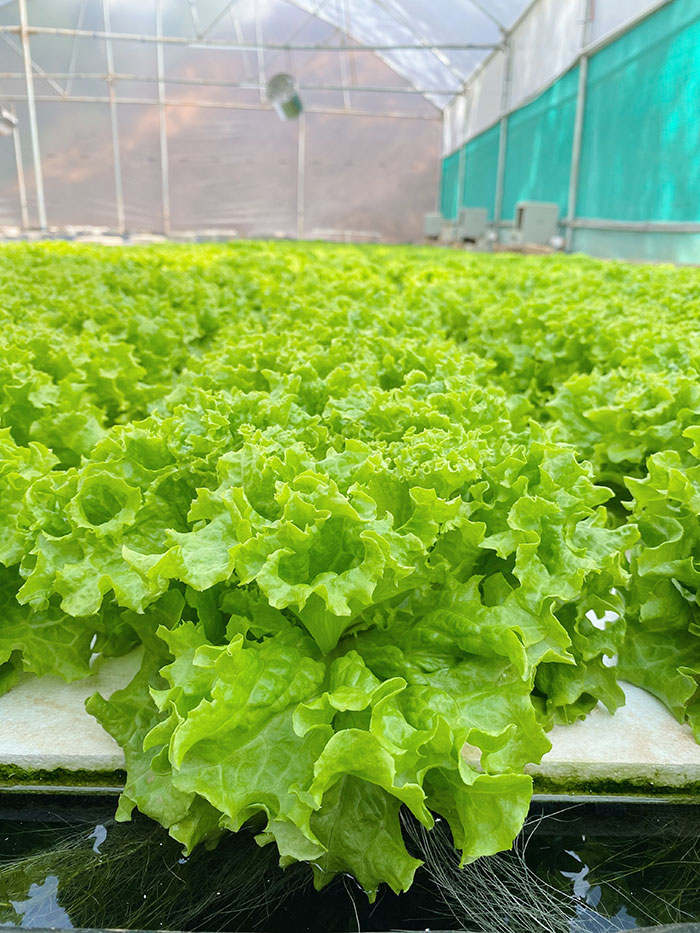Yangyel Lhaden
Premise — Urbanisation and rapid development, along with other factors such as crop damage by wild animals, land fragmentation, destruction of crop by pests and diseases, rising temperatures and insufficient supply, are making agriculture less productive. Consequently, Bhutan’s food security and food self-sufficiency are becoming more a distant dream.
Bhutan today has only about eight percent or 277,000 acres of arable land. Of this total, only 23 percent is being cultivated.

It is against this backdrop that hydroponics, a type of horticulture and a subset of hydroculture that does not use soil to grow crops, is seen as a critically important solution. The main benefit of hydroponics, among many others, is that the system can grow plants and vegetables much faster than on the conventional setting in soil.
The temperature reading is 10 ˚C, pH 6.2, and nutrient level 1.4. This is the optimum level. Nothing needs to be done.
Karma Lam Dorji’s tech-driven poly-house Bhutan L-Farm, in Ngabiphu, Thimphu, grows more than nine varieties of lettuce and herbs. In a year, Karma can harvest crops four times. If grown in soil, the maximum cycle is twice a year.
“No dirt, no digging, weed, or pest. I don’t have to worry about weather fluctuations. The greatest advantage is that I don’t need helpers,” says Karma Lam Dorji, who started the project without any farming experience.
Karma started hydroponics when four Agriculture Research and Development Centres (ARDC) in the country were performing their first ever hydroponics trials. It all began with a chance meeting with a friend in Delhi, India not so long ago who happened to be a hydroponics expert and consultant. What began as a pastime activity is now a serious venture.

How does hydroponics function?
The secret lies in nutrient mix, what Karma calls the “formula”, which is not shared among hydroponics users. Karma had to study expansively about hydroponics system, from farm size to nutrient requirements. The ready-made nutrients supplied by Envirevo Agritech to ARDCs have no specification of the type of plant nutrient and their content percentage.
“Knowing what nutrient and quantity is required by the plants is thus very challenging,” an ARDC official said.
Karma’s farm operates on deep-water technique (DWT). In this system, foam floats on the nutrient-fed water. Holes are pierced through the foam for planting. Water circulates through pumps in the system, which allows mixing and distribution of nutrients. To create oxygen, there is a fountain. There are heaters and fans for air circulation.
Bhutan’s agriculture is dependent on monsoon rain. With changing weather and climatic conditions, water shortage is already a major issue in the country, especially in rural parts. Studies have suggested that impacts of climate change are likely to add to the burdens of farming.
Can anyone do
hydroponics?
The system is expensive. But recurrent expenditure is low.
Karma invested Nu 1.5 million in building the system, but he sees it as an answer to achieving food security in the country.
The Covid-19 pandemic made Bhutanese realise that achieving self-sufficiency is all the more important. Increased production can offset import.
In 2020, urban and peri-urban agricultural programmes in and around Thimphu engaged 22 groups. Within eight months, 35 percent of the groups abandoned their fields. Without heavy mechanisation, agriculture is labour intensive.
Karma, however, said, with DWT, he could only grow greens. His plan now is to start a nutrient film technique to grow heavier vegetables, such as tomato and chili. “Whenever I have problems, I send pictures to my consultant for intervention.”
His most popular greens are iceberg and butterhead, which he supplies to residents and a restaurant in Thimphu.
Karma said that one of the reasons why young people are not interested in agriculture was because of dirt, farmhand shortage, and labour intensive nature of the traditional way of farming.
“In that sense, hydroponics could be the best solution. Manpower required is less and yield more than double,” says Karma. “You can grow plants with shallow root systems and plants that are known for reproducing and there’s no dirt to be worried about.”

